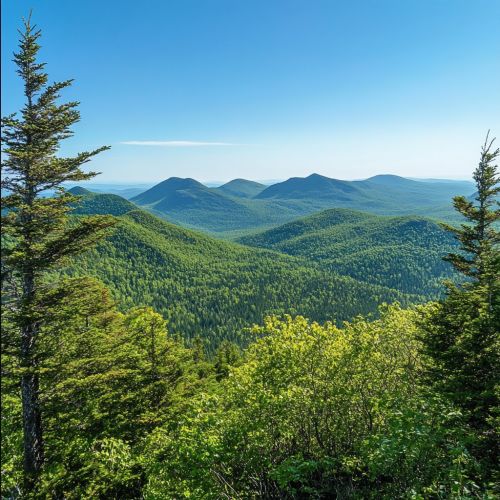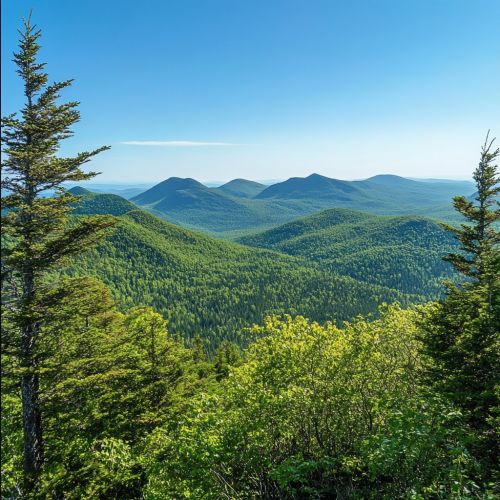Mount Mitchell
Geography and Geology
Mount Mitchell is the highest peak in the Appalachian Mountains and the highest peak in mainland eastern North America. It is located in the Black Mountain subrange of the Blue Ridge Mountains, part of the larger Appalachian Mountain range. The mountain is situated in Yancey County, North Carolina, within the Pisgah National Forest.
The summit of Mount Mitchell reaches an elevation of 6,684 feet (2,037 meters) above sea level. The mountain is named after Dr. Elisha Mitchell, a professor at the University of North Carolina, who conducted extensive studies of the Black Mountains in the mid-19th century.
The geology of Mount Mitchell is characterized by Precambrian metamorphic rocks, primarily gneiss and schist. These rocks are among the oldest in North America, dating back over a billion years. The mountain's rugged terrain is the result of millions of years of erosion, which has shaped its steep slopes and deep valleys.


Climate
Mount Mitchell experiences a humid continental climate, which is rare in the southeastern United States. The high elevation results in significantly cooler temperatures compared to the surrounding lower areas. The average annual temperature at the summit is around 43°F (6°C), with summer temperatures rarely exceeding 70°F (21°C) and winter temperatures often dropping below freezing.
Precipitation is abundant, with an average annual rainfall of approximately 80 inches (2,032 mm). Snowfall is also common in the winter months, with an average annual accumulation of around 100 inches (2,540 mm). The combination of high precipitation and cool temperatures creates a unique environment that supports a variety of plant and animal species not typically found in the southeastern United States.
Flora and Fauna
The diverse climate and elevation of Mount Mitchell support a wide range of flora and fauna. The lower elevations are dominated by deciduous forests, including species such as oak, hickory, and maple. As the elevation increases, the forest composition changes to include more coniferous species, such as red spruce and Fraser fir.
The summit area is characterized by a unique spruce-fir forest, which is more commonly found in the northern United States and Canada. This forest type is home to several rare and endangered plant species, including the Carolina hemlock and the Blue Ridge goldenrod.
The fauna of Mount Mitchell is equally diverse, with species adapted to the varying elevations and habitats. Common mammals include black bears, white-tailed deer, and bobcats. The mountain is also home to a variety of bird species, such as the peregrine falcon, the northern saw-whet owl, and the black-capped chickadee.
Human History
The history of human activity on Mount Mitchell dates back thousands of years. The Cherokee people, who inhabited the region before European settlers arrived, referred to the mountain as Attakulla. They used the area for hunting and gathering, and it held spiritual significance for them.
European exploration of the region began in the 18th century, with settlers gradually moving into the area. Dr. Elisha Mitchell's studies in the 1830s and 1840s brought significant attention to the mountain. Tragically, Dr. Mitchell died in 1857 while attempting to verify his measurements of the mountain's height. His body was later interred at the summit, and the mountain was named in his honor.
In the early 20th century, efforts to preserve the natural beauty of Mount Mitchell led to the establishment of Mount Mitchell State Park in 1915. This was the first state park in North Carolina and remains a popular destination for hikers, campers, and nature enthusiasts.
Ecology and Conservation
Mount Mitchell's unique ecosystems are of significant ecological importance. The spruce-fir forest at the summit is particularly vulnerable to environmental changes, including air pollution, acid rain, and climate change. These factors have contributed to the decline of the Fraser fir population, which has been severely affected by the balsam woolly adelgid, an invasive insect species.
Conservation efforts are ongoing to protect and restore the natural habitats of Mount Mitchell. The establishment of Mount Mitchell State Park has played a crucial role in preserving the area's biodiversity. The park encompasses over 4,000 acres (1,619 hectares) and provides a protected environment for the mountain's flora and fauna.
Research and monitoring programs are in place to study the impacts of environmental stressors on the mountain's ecosystems. These programs aim to develop strategies for mitigating the effects of pollution and climate change, ensuring the long-term health and resilience of Mount Mitchell's natural habitats.
Recreation and Tourism
Mount Mitchell State Park offers a variety of recreational opportunities for visitors. The park features several hiking trails, ranging from easy walks to challenging climbs. The most popular trail is the Mount Mitchell Trail, which ascends from the Black Mountain Campground to the summit, covering a distance of 5.6 miles (9 km) with an elevation gain of over 3,600 feet (1,097 meters).
The summit area includes an observation deck, which provides panoramic views of the surrounding mountains and valleys. On clear days, visitors can see as far as 85 miles (137 km) in all directions. The park also offers picnic areas, a museum, and a restaurant, making it a popular destination for day trips and family outings.
Camping is available at the Black Mountain Campground, located at the base of the mountain. The campground provides a range of amenities, including tent and RV sites, restrooms, and showers. Backcountry camping is also permitted in designated areas, allowing visitors to experience the mountain's natural beauty up close.
Scientific Research
Mount Mitchell has been the focus of extensive scientific research due to its unique environmental conditions and biodiversity. Studies have been conducted on various aspects of the mountain's ecology, geology, and climate. Researchers have investigated the impacts of air pollution on the mountain's forests, the effects of climate change on its ecosystems, and the distribution and behavior of its wildlife.
One significant area of research is the study of the spruce-fir forest ecosystem. Scientists have examined the factors contributing to the decline of Fraser fir populations, including the role of the balsam woolly adelgid and the effects of acid rain. These studies have provided valuable insights into the challenges facing high-elevation forests and have informed conservation strategies aimed at preserving these critical habitats.
Another important area of research is the study of the mountain's climate. Meteorologists and climatologists have used data from weather stations on Mount Mitchell to analyze long-term trends in temperature, precipitation, and snowfall. This research has contributed to a better understanding of the regional climate and its potential impacts on the environment and human activities.
Cultural Significance
Mount Mitchell holds cultural significance for both the indigenous Cherokee people and the European settlers who followed. For the Cherokee, the mountain was a place of spiritual importance and a source of natural resources. The name "Attakulla" reflects the mountain's prominence in their culture and history.
For European settlers, Mount Mitchell represented a scientific and exploratory frontier. The work of Dr. Elisha Mitchell and other early researchers highlighted the mountain's unique characteristics and contributed to the broader understanding of the Appalachian region. The establishment of Mount Mitchell State Park in the early 20th century reflects the ongoing appreciation of the mountain's natural beauty and ecological importance.
Today, Mount Mitchell continues to inspire visitors and researchers alike. Its rugged landscapes, diverse ecosystems, and rich history make it a valuable natural and cultural resource. Efforts to preserve and protect the mountain ensure that future generations can continue to explore and appreciate its many wonders.
See Also
- Appalachian Mountains
- Blue Ridge Mountains
- Pisgah National Forest
- Fraser Fir
- Balsam Woolly Adelgid
- Elisha Mitchell
